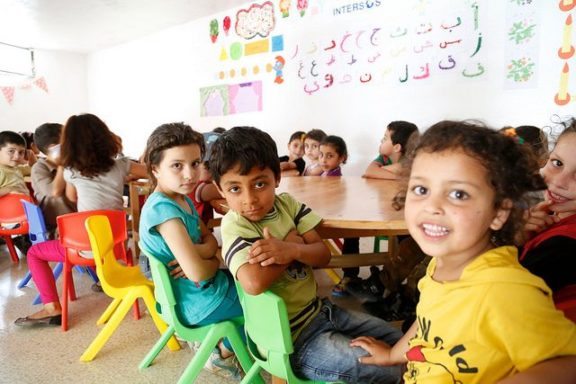
April 18, 2017; National Public Radio, “nprED”
Only half of refugee children have access to primary education, as compared with 91 percent of children worldwide. Nonprofits and corporations alike are exploring using technology to create school based-learning opportunities; the results have been mixed.
The unrelenting conflict in Syria has spiraled into its seventh year. The war has taken the lives of close to half a million people. Over twelve million, or half of the country’s prewar population, have fled many to neighboring countries. Before the war, 94 percent of Syrian children were attending primary or secondary school. Now, the United Nations’ refugee agency (UNHCR) estimates 900,000 are not enrolled, including over half a million living in Jordan, Turkey, and Lebanon—a decrease from 715,000 in these countries in February 2016.
Concern over this staggering lack of access to education follows a conference in London in February 2016 and a second in Brussels on April 5, 2017. During the London conference, attendees, including donors and host countries, pledged to have all Syrian refugee children in school by the end of the 2016-7 school year. The U.S. pledged $933 million in aid, including $350 million directed to refugees in Lebanon and $250 million to Jordan. The pledge was remarkable given its size and the acute funding decline in previous years, particularly in areas of fighting across the world according to UNESCO.
Sign up for our free newsletters
Subscribe to NPQ's newsletters to have our top stories delivered directly to your inbox.
By signing up, you agree to our privacy policy and terms of use, and to receive messages from NPQ and our partners.
The critical funds and subsequent massive interest brought attention to the needs of Syrian children. Overall, 144 non-state organizations were involved, according to a recent study authored by Zeena Zakharia and Francine Menashy of the University of Massachusetts, Boston, and released by Education International, a global federation of teachers’ unions. During the nine-month research period (May 2016 through February 2017), they identified 46 corporations, including Goldman Sachs, Hewlett Packard, IBM, and Microsoft, and fifteen private foundations, including the Bill & Melinda Gates Foundation, the IKEA Foundation, and the Open Society Foundation. Forty-two percent of the participating organizations were businesses and private foundations, over three-quarters were from the Global North, and over 60 percent did not primarily focus on education.
Unfortunately, the study also found that the funds were not used very effectively, mostly due to a lack of on-the-ground coordination, an excessive dependence on technology, and friction between nonprofit and corporate objectives. For example, the authors found only one percent of funds directed toward children’s social and emotional skills and five percent on extracurricular activities, while half underwrote educational technology. This was in areas where children had one hour of electricity a day at best.
The study is an example of funders’ desire to distribute aid quickly to build their brands rather than long-term connections or an understanding of the environment. Identifying local partners and building relationships take time but yield more valuable results.—Gayle Nelson
Correction: This article has been altered from its original form to correct an error. As per the UNHCR report, 49 percent of refugee children globally lack access to primary education, as opposed to only those refugee children in the U.S. NPQ regrets the mistake.













